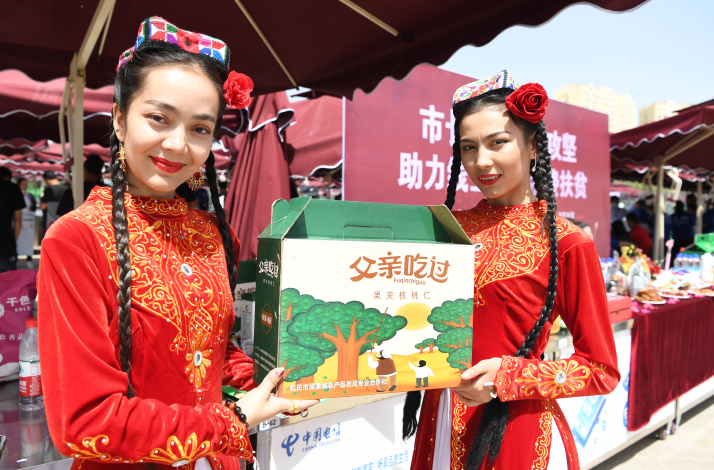The largest autonomous region in China continues to shake off poverty
Beijing Review,June 29, 2020 Adjust font size:

Farmers enjoy a meal in Taxkorgan Tajik Autonomous County in Xinjiang on June 17, 2019 (XINHUA)
Musa Axim, a 60-year-old in Payzawat County, Xinjiang Uygur Autonomous Region in northwest China, has formed a new habit of drinking a glass of tap water every morning since June 16, when the county for the first time got access to safe drinking water.
"It tastes sweet. For a long time in the past, we used large buckets to fetch water from a river afar, which was not clean enough, especially in flooding season," Axim told China News Service.
The 15,300 residents in Payzawat, part of Kashgar, are the last batch of people in the region that got access to clean water. For the southern part of Xinjiang, in particular, which includes Kashgar, Kizilsu, Aksu and Hotan, where the weather is dry, people had difficulty to access safe drinking water.
In 2016, the Central Government made it a priority to bring safe drinking water to all of Xinjiang, investing 12.2 billion yuan ($1.72 billion) in over 400 water projects.
The Payzawat project, with total investment of about 1.75 billion yuan ($247.5 million) fetches water from a river over 100 km from the county seat to every household in the county via 1,827 km of pipelines, according to Zhang Yun, Director of Xinjiang's management center of rural drinking water safety.

Children play in what's called the Dove Lane in Tuancheng Old Town of Hotan in Xinjiang Uygur Autonomous Region on May 27 (XINHUA)
Many advantages
Since the founding of the People's Republic of China in 1949, the Central Government has made great efforts to improve people's livelihood in Xinjiang, enhancing these efforts in late 2013, when the country launched its targeted poverty alleviation campaign.
Covering about 17 percent of the total land area of the country, Xinjiang is home to only 2 percent of China's total population. Over 22 million people from 47 ethnic groups are sparsely distributed across the vast land that borders eight countries. The region is blessed with a colorful culture and picturesque scenery; however, unfortunately, it has also been a target of terrorists, extremists and separatists.
The complex geographical feature of the region, which includes large deserts, snow-covered mountains, grasslands and basins, has made transportation difficult, poverty more common and poverty alleviation more challenging than many other areas in the country.
However, the advantages of this region are also obvious. A spectacular landscape, ethnic diversity and fascinating cuisines have combined to make it an enticing tourist destination. The land is endowed with rich agricultural resources. Tourism and agriculture have become two pillar industries in the region's fight against poverty.
Huocheng County in north Xinjiang has similar weather and soil conditions as Provence in France and is suitable for planting lavender. In the mid-1960s, it introduced French lavender. Dubbed China's lavender town, it has the largest lavender production base in the country, accounting for 97 percent of China's lavender output, with over 3,500 hectares devoted to the plant.
The plant with purple flowers has become a main source of income for locals. Hou Maomao was one of the first batch of farmers to plant lavender in Sigong Village. When he transformed his 1-hectare farmland from cropland to lavender field in 2014, his family was still registered as a poor household. With lavender planting tripling his income, in 2016, Hou's family climbed out of poverty, earning an annual income exceeding 50,000 yuan ($7,000). That year, the family moved into a new house.
In addition to lavender, farmers in Xinjiang have found opportunities in growing a portfolio of other plants. Rose plantation bases have followed a similar development mode. For example, locals in Hotan have set up a complete production line from planting roses to processing rose jam.
For farmers living near deserts, drought-resistant shrubs such as saxaul have become solutions to their poverty.
In Shanshan County, 69 households living near the Kumtag Desert have been growing these plants to battle desertification and poverty. Farmers receive a subsidy for planting saxaul.
Xinjiang is also well known for its fruit. Substantial sunshine and considerable temperature difference between day and night makes the region's fruit particularly sweet. Luntai County has a 2,500-year history of growing small white apricots. In order to make the fruit a cash cow for the farmers, the local government invited experts to deliver training in planting, processing and marketing, and even set up associations to boost the fruit business.
It has built an information and logistics platform offering a full range of services. In addition, it has launched an annual Apricot Blossom Festival, which has now become a major tourist attraction.
Tourists attracted to various flower and fruit festivals in Xinjiang have also explored nearby places. Tuyoq, a little-known ancient village located at the foot of the Flaming Mountains, has thus become a famous destination.
Home to 1,380 Uygur households, Tuyoq used to be one of the poorest villages in Turpan. With efforts to improve infrastructure, clean the environment, build homestays, create food streets and train locals in catering services, the village has lured an increasing number of tourists, enabling more locals to find jobs in tourism.
Last year, Xinjiang received more than 200 million visitors and tourism revenue exceeded 340 billion yuan ($47.9 billion). This year, despite being affected by the novel coronavirus disease (COVID-19), Xinjiang still plans to invest 880 million yuan ($124.3 million) in constructing and upgrading tourism service facilities across the region, with the aim of generating 50,000 jobs in the tourism industry, so that more locals can earn "tourism money."
Meanwhile, the quick development of the digital economy in Xinjiang has boosted marketing of agricultural products and tourism. The region's industry and information technology department announced in early June that it will expand the digital economy by 10 percent this year.

Tourists and locals enjoy local entertainment at a guesthouse in Kashgar in Xinjiang Uygur Autonomous Region, northwest China, on May 17 (XINHUA)
Local and national support
The Central Government has emphasized infrastructure construction and created a more business-friendly environment in Xinjiang. The expressway linking Altay Prefecture and the region's capital city of Urumqi, the first cross-desert expressway, is expected to be completed in August 2022 and will shorten the travel time between the two areas by almost half.
This year, the region will invest over 2 billion yuan ($282 million) to build nearly 4,900 5G base stations, the regional communications administration revealed on June 8. By the end of this year, urban areas of Urumqi are expected to get full 5G coverage, while other prefectures and cities will also have access to 5G network.
Moreover, the Belt and Road Initiative, launched in 2013, has given Xinjiang a key position as an important juncture along the Silk Road. The freight train connecting China with Europe via Xinjiang has made the region a new investment hotspot.

Two women demonstrate local agricultural products via live-streaming on May 27 (XINHUA)
"We have set up three textile industrial parks in Kashgar, providing 2,600 jobs, with more than 90 percent local employees," said Zhou Hongrun, President of Xinjiang Ruyi Textile Co. Ltd.
New workers are offered three months of training. "During the three months, they earn 1,800 yuan ($255) per month, after which they can make 3,000 yuan ($424) monthly," Zhou said. "A worker from a poor family can greatly relieve the family's financial burden with this income."
A total of 19 provinces and municipalities have paired with Xinjiang's 14 prefectures and cities to offer assistance. They have been offering financial and personnel support, building new infrastructure and funding local industry since 2011. For instance, Jiangsu and Jiangxi provinces in east China have invested 802 million yuan ($113.4 million) since the 13th Five-Year Plan (2016-20) was adopted to help Kizilsu Kirgiz Autonomous Prefecture, located on the border with Kyrgyzstan and Tajikistan in western Xinjiang.
Jiangsu has helped build several industrial parks, attracting 129 enterprises and providing jobs to over 6,200 people. Jiangxi has constructed an agricultural scientific and technological demonstration park, a textile and apparel industrial park and a small and micro business incubation park in Akto County, bringing 86 enterprises and providing employment for over 4,000 people.
Several provinces have also invested money in building bilingual, vocational and middle schools, sending teachers from their provinces and municipalities to Xinjiang for years at a time. Figures from local authorities show that in 2019, Xinjiang spent 86.31 billion yuan ($12.33 billion) on education, a year-on-year increase of 5.85 percent. So far, all the preschool children aged 4 to 6 in the autonomous region are receiving preschool education in kindergartens, and have free lunches, snacks and fruits.
In 2018, a three-year plan was launched to significantly improve the living environment in Xinjiang's rural areas by 2020, including popularizing hygienic toilets and improving waste management. So far, 510 million yuan ($71.5 million) has been invested in the project, 60 percent of the total investment in the region for 2019.
On June 19, figures released by local authorities showed that from 2014 to 2019, nearly 3 million residents moved out of poverty in Xinjiang.
"The poverty alleviation work in Xinjiang has made decisive achievements," Liu Yongfu, head of the State Council Leading Group Office of Poverty Alleviation and Development, said at a conference held in Hotan on May 16. He said, "This year is the final year of China's poverty alleviation campaign. Overcoming the negative impacts of COVID-19 and accelerating development in the region to help the impoverished are top priorities for the region."